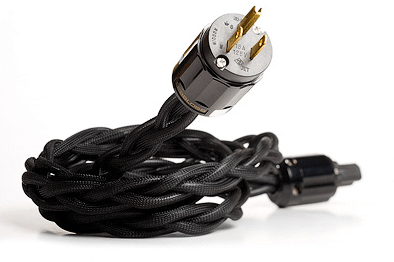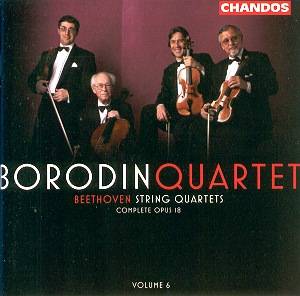LessLoss BTB Power Cables
| LessLoss BTB Power Cables |
| Bang For the Buck? |
|
|
|
September 2008 |

This is a (brief) follow-up review of the lower-priced LessLoss Power Cord called the BTB, “Bang for The Buck.”
There is a substantial price difference to the Dynamic Filtering Power Cord. The BTB retails for $375, the DFPC for $569 (in both cases, quantity discounts are available). There are a number of material differences as well, as a glance at the accompanying photograph will show. Different plugs, different size wires.
The DFPC uses the Oyaide 079 plug, the BTB uses the Oyaide 029. The 079 is constructed with pins of machined, polished phosphorous bronze plated with 2.0 microns of 24K gold. The 029 is Oyaide’s least expensive audio plug. It uses unplated, unpolished brass pins, which appear to have been stamped, not machined. But like the 079, the body of the 029 is black polybutylene terephtalate (carrying 30% glass particles). In addition to being immune to temperature extremes and humidity, the hardness of this material assures there will be no flexure of the pins, preserving the integrity of the factory-crimped internal wires. (The crimp has a pull strength greater than 30kg.) The cap of the plug is opaque black polycarbonate, rather than translucent ruby polycarbonate. However the grip of the IEC plug feels to me at least as firm as the 079, far superior to the grip of the OEM plug.
Oyaide audiophile plugs also include rhodium/silver plating, and rhodium/gold plating. LessLoss obviously preferred the sound of the 079’s extra-thick, gold-only plating. One issue not mentioned by Oyaide, or LessLoss for that matter, is the potential effect of dissimilar metal contacts . Standard AC outlets use internal parts made of brass, like the pins of the 029. “Audiophile” AC outlets tend to use internal parts plated with gold, like the pins of the O79. Now, the Oyaide web site states that …“[p]lating material and quality change sound dramatically. Where Rhodium sounds pure and strong, Gold sounds warm, soft and luxurious.” They do not comment on the “sound” of brass, perhaps because it is subject to corrosion (diode effect) and, because it is unpolished and provides a more uncertain contact surface. But by the same token it stands to reason that the contact material in the AC outlet, and the similarity/dissimilarity of the mating material, will also have an effect on the sound. Unfortunately, no gold audiophile AC sockets were available. I could only test unpolished brass to unpolished brass, and polished gold to unpolished brass. Too many variables for comfort.
The wires comprising the BTB are smaller gauge than the DFPC. The total cross sectional area of the DFPC is 18mm2 so each wire is 6mm2 (between 9 and 10 gauge) for a continuous current rating greater than 15 amperes. The total cross sectional area of the BTB is 13.5mm so each wire is 4.5mm (between 10 and 11 gauge) for a continuous current rating greater than 12 amperes. At a standard line voltage of 115VAC, this represents a minimum continuous capacity of 1725 watts and 1380 watts, respectively, power levels that normally occur for only very brief periods when the volume control is turned way up. To put this in some perspective, house wiring in the USA is generally limited to 15A per circuit, beyond which a circuit breaker or fuse pops.
The core wire used in manufacturing the BTB is the same as that used in the DFPC. The difference in gauge between the two is due to the difference in the thickness of the applied porous, conductive skin (which does the filtering). Not knowing exactly how this proprietary material works makes it difficult to speculate on the physics involved, but Louis Motek of LessLoss notes that the BTB is “somewhat less effective” at filtering. The dielectric covering the BTB wire is thinner than that used on the DFPC, resulting in a cord that is both thinner and more flexible. (There are some who would say that less or more, when it comes to dielectric material.) LessLoss’s “FlowFlux” treatment is applied to the BTB just as it is to the DFPC.
Finally, it might be or interest to know the audio equipment I used for these evaluations: Accuphase DP90 transport, Bel Canto DAC3 converter/preamp, Bel Canto REF1000 monoblock amplifiers, modified Newform Research R645 (V1) loudspeakers (reinforced cabinets, external crossovers using premium parts), Nordost Flatline Gold loudspeaker cable, Accuphase OEM balanced digital cable, and home-made balanced interconnects (Belden 1600F wire/Neutrik Gold connectors).
To break-in the BTB cords (and my ears), I unplugged the DFPCs and sat back and listened to the BTBs for the better part of a week. As I’ve said elsewhere, “break-in” is a vexed issue, but I must say that from the start, the BTBs seemed extraordinary. It took some will power not to switch back and forth, and to just enjoy the music. And very enjoyable it was too: the traits I’d noted in my review of the DFPC were also descriptive of the BTBs: clarity, definition, dynamics. But the BTBs also seemed to sound different than the DFPCs. I couldn’t put my finger on it, nor was this the time to do so. I am, as I’ve said, a novice in the world of audiophile power cords, but it seemed to me that this level of improvement, for this price, was a bargain in spades. How much would the DFPCs differ from their little brothers?
Not much.
The LessLoss web site says of the BTB: “Does 95% of what the LessLoss Dynamic Filtering Power Cable does.” What about that 5%? Audiophiles sometimes spend small fortunes to obtain an extra 5%. In this case that five percent may represent the greater filtering ability of the DFPC. The difference in sonics however is not quantifiable as a percentage.
This is the part of reviewing equipment I don’t like, the part that leaves me uncomfortable: when the differences between two items under test are very subtle. I grew up in audio keenly aware of the many idiosyncrasies of aural perception, which is why, when it comes to subtle differences, the formality of double-blind testing would be a real comfort. Few reviewers, myself included, have that luxury, however. We must work around, for instance, the scientifically accepted fact that aural memory is extremely short. And getting up and walking to the equipment rack, powering down three pieces of equipment, pulling three power cords, installing three other power cords, powering up three pieces of equipment, returning to my listening seat and readjusting volume, well, it takes time. Moreover, I know which cord is under test, and it is another scientifically accepted fact that this knowledge prejudices my perceptions. All of this notwithstanding, I have formed impressions. And they are pretty consistent.
In several preliminary comparisons using piano music, the BTB sounded to me more “etched” and the DFPC more “refined.” Consider a black box that just maybe has marginally superior resolution, over a second black box that sounds a just bit staid and unexciting. When the black boxes are opened, the first device is shown to have a 2dB rise between 500Hz and 2000Hz, whereas the second device is shown to be flat within 0.5dB throughout the audio spectrum. Please bear in mind this is merely a crude quantitative analogy; I make no claim to explain of what “etched” and “refined” consist, but certainly frequency response has nothing whatever to do with it. Another tester would undoubtedly use different adjectives.
 Beethoven: String Quartet Opus 74 (Chandos 10191). I thought it might be interesting to compare these two cords using the same CD I’d used to review the DFPC. Here again there was a subtle difference, but different adjectives seem applicable. The BTB sounded, for want of a better vocabulary, a bit “thin.” While the DFPC sounded “full bodied.” Another analogy springs to mind: I am reminded of a beef oregano stew I made for the second time a few weeks ago. I followed the recipe exactly but something was missing, it just didn’t make the taste buds dance and celebrate like the first one had. A day later I remembered I had modified the recipe for the first batch, adding half a teaspoon of dried lavender. Even that’s too strong an image: there is nothing lacking in the BTB, the instruments are articulate and dynamic, the music is involving and amazing. But the DFPC adds something to the mix, the strings sound one and all more embodied. Perhaps just a bit more like they’re here in the room, with more air around them.
Beethoven: String Quartet Opus 74 (Chandos 10191). I thought it might be interesting to compare these two cords using the same CD I’d used to review the DFPC. Here again there was a subtle difference, but different adjectives seem applicable. The BTB sounded, for want of a better vocabulary, a bit “thin.” While the DFPC sounded “full bodied.” Another analogy springs to mind: I am reminded of a beef oregano stew I made for the second time a few weeks ago. I followed the recipe exactly but something was missing, it just didn’t make the taste buds dance and celebrate like the first one had. A day later I remembered I had modified the recipe for the first batch, adding half a teaspoon of dried lavender. Even that’s too strong an image: there is nothing lacking in the BTB, the instruments are articulate and dynamic, the music is involving and amazing. But the DFPC adds something to the mix, the strings sound one and all more embodied. Perhaps just a bit more like they’re here in the room, with more air around them.
Both of these cords are stunners in my stereo; and I could readily understand someone favoring the BTB. I did myself, at first. But with more listening I inclined to the DFPC (despite a certain intellectual discomfort in knowing that theoretically it delivers cleaner power, ergo it ought to sound better: a proposition that doesn’t necessarily hold water). In light of the astronomical prices being paid for audiophile power cords, anyone in the market would be doing themselves a disservice not to audition one or both of these remarkable cords from LessLoss.

![]()
Manufacturers Note: ALL PRICING ALREADY INCLUDES SHIPPING FEES.
Price: $375.00 ea
LessLoss Audio Devices
P.D. 1231
46005 Kaunas
Lithuania
Tel.: +370 698 48706
email: info@lessloss.com
web info and store: www.LessLoss.com
![]()
Don’t forget to bookmark us! (CTRL-SHFT-D)
Stereo Times Masthead
Publisher/Founder
Clement Perry
Editor
Dave Thomas
Senior Editors
Frank Alles, Mike Girardi, Key Kim, Russell Lichter, Terry London, Moreno Mitchell, Paul Szabady, Bill Wells, Mike Wright, Stephen Yan, and Rob Dockery
Current Contributors
David Abramson, Tim Barrall, Dave Allison, Ron Cook, Lewis Dardick, Dan Secula, Don Shaulis, Greg Simmons, Eric Teh, Greg Voth, Richard Willie, Ed Van Winkle, and Rob Dockery
Music Reviewers:
Carlos Sanchez, John Jonczyk, John Sprung and Russell Lichter
Site Management Clement Perry
Ad Designer: Martin Perry





Be the first to comment on: LessLoss BTB Power Cables